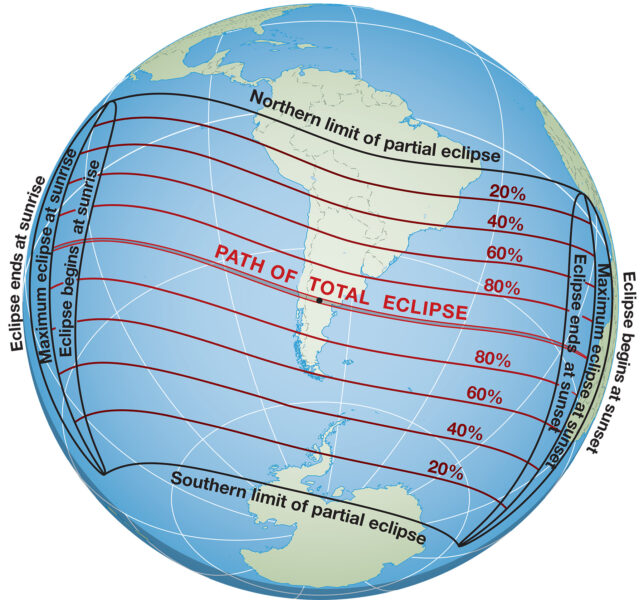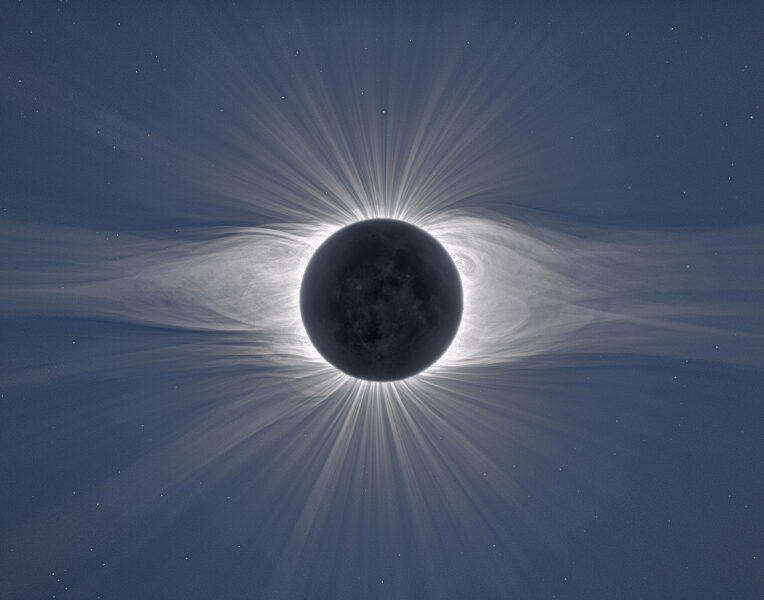The Moon’s shadow visits Chile and Argentina again. If you can’t be there, we’ve listed several livestreaming webcasts.

Gregg Dinderman / S&T, Source: Fred Espenak
Concerns about COVID-19 may put a crimp in travel plans for many of us hoping to see the December 14th total solar eclipse, but the show will go on regardless.
I booked a flight to Argentina for the event, but as I write this (at the start of September), international travel remains iffy. Thousands of eager umbraphiles may find themselves in the same situation as we collectively grapple with a pandemic that has upended so many lives. Never fear. Even if you can’t make it to the centerline, you’re guaranteed a front row seat via livestreaming from the Exploratorium Museum in San Francisco and at timeanddate.com.
Other livestreaming events to check out include:
- Virtual Telescope, starting at 14:30 UTC, in cooperation with the Asociación Argentina Astronomía and ALMA observatory.
- NASA TV includes camera views of total eclipse and a Spanish-language program.
- Carnegie Science program with John Mulchaey, director of Carnegi Observatories (free, but requires registration).
- Slooh's livestream
- CosmoSapiens will livestream the event from Argentina.
- RTN Radio y Televisión del Neuquén
Much like the 2019 South America eclipse, the track of totality once again crosses Chile and Argentina, but this time about 1,000 kilometers (620 miles) farther south, and during Southern Hemisphere summer. The Moon’s shadow touches down at sunrise on the 14th (14:33 UT) in the South Pacific. It rapidly heads east, making landfall 97 minutes later on the Chilean coast, where lucky viewers can catch 2 minutes and 8 seconds of totality. Traveling at 2,400 kilometers per hour, the lunar shadow dashes across the narrow country in 4 minutes, descending from the towering peaks of the Andes down to the deserts and tablelands of Argentina’s Patagonia region.

Miloslav Druckmüller / Peter Aniol
Weather prospects are generally good along the 700-kilometer-long Argentinian eclipse track. Perhaps the best place to view the event is north of the town of Piedra del Águila, which has a 30% average cloud cover at this time of year. Greatest eclipse occurs 180 kilometers to the east, where observers can experience 2 minutes and 10 seconds of totality, with mid-eclipse occurring at 16:13:30 UT.
Six minutes later, tourists sunning on the beach in the popular coastal resort town of Las Grutas need only peer over the tops of their sunglasses to enjoy 2 minutes and 6 seconds of totality before the Sun reappears and tanning resumes. The shadow then leaves Argentina and travels 7,000 kilometers across the South Atlantic Ocean before departing Earth off the coast of Namibia, at 17:54 UT — 3 hours and 21 minutes after the eclipse started.
Within the umbra’s path, observers can watch for Baily’s Beads just before and after totality, when bits of the solar photosphere briefly shine through gaps along the Moon’s rugged limb. As always during a solar eclipse, you must use a safe solar filter or eclipse glasses except during totality, when the solar is completely covered by the Moon.
During totality, have a pair of binoculars at the ready to inspect the bright pinkish-red chromosphere. Chances are you’ll see one or more prominences of incandescent hydrogen poking out beyond the dark lunar limb. Most eclipse watchers would agree that the Sun’s corona is the event’s most mesmerizing sight. The pearly, unearthly nimbus of light dramatically frames the blackened Moon. Wide-field binoculars reveal the corona’s magnetic nature. You can clearly see filaments and whorls of hot gas that recall iron filings around a magnet, as hot coronal gases bend to the will of the solar magnetic field. During solar minimum (currently underway), the corona often appears asymmetric, with long, taffy-like structures on either side of the Sun’s equator and vertical field lines streaming from polar coronal holes.
We actually see two coronas during a total eclipse. There’s the inner portion called the K corona, comprising free electrons illuminated by sunlight. Beyond that, the F corona or “dust corona” begins. Here, sunlight scatters off particles shed by comets and asteroids along the plane of the solar system. The F corona expands into the zodiacal light, visible at dawn in autumn and dusk in spring.
During totality’s brief twilight-darkness, listen for night insects — such as crickets — feel the sudden chill in the air, and relish the fact that you’re part of a cosmic alignment along with the Sun and the Moon. Take a few moments to look around the sky, too. Four planets will be visible: Mercury and Venus (found 3° and 24° west of the Sun, respectively), and the close duo of Jupiter and Saturn 35° to the Sun’s east.
Before you know it the eclipse will come to an end. Baily’s Beads make a final appearance, and the shadow that descended in apocalyptic haste when totality began now hurries away ahead of the returning daylight. Yes, it all goes by too fast.
Two-thirds of South America and a portion of Antarctica will witness a partial eclipse, with 79% of the Sun covered in Santiago, Chile; 74% in Buenos Aires, Argentina; 32% in São Paulo, Brazil; 17% in Lima, Peru; and 1.4% in Guayaquil, Ecuador. For details of the eclipse along the entire path of totality, check out Xavier Jubier’s interactive eclipse map.
This article originally appeared in the December 2020 issue of Sky & Telescope.
If you're able to witness the event, share what you see! Users can share photos with Sky & Telescope in our online Gallery.
 0
0









Comments
You must be logged in to post a comment.